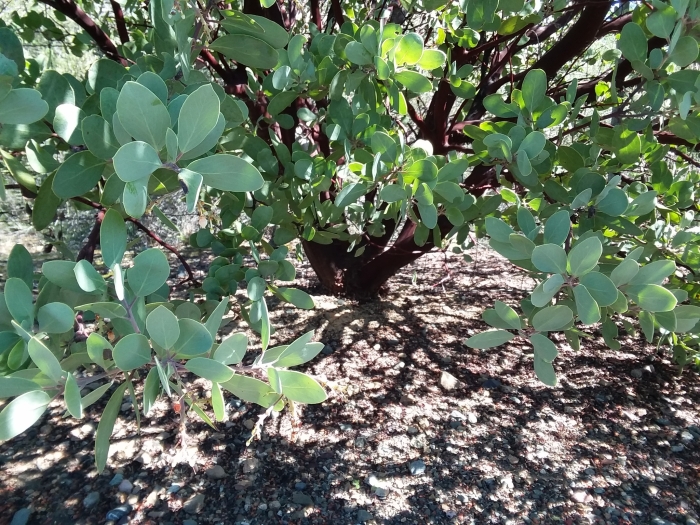Whiteleaf Manzanita
(Arctostaphylos manzanita)
Whiteleaf Manzanita (Arctostaphylos manzanita)
/
/

Kayla Sweeten
CC BY 4.0
Image By:
Kayla Sweeten
Recorded By:
Copyright:
CC BY 4.0
Copyright Notice:
Photo by: Kayla Sweeten | License Type: CC BY 4.0 | License URL: http://creativecommons.org/licenses/by/4.0/ | Rights Holder: Kayla Sweeten | Publisher: iNaturalist | Date Created: 2021-03-27T12:24:10-07:00 |


























































Estimated Native Range
Summary
Arctostaphylos manzanita, commonly known as Whiteleaf Manzanita, is an evergreen shrub native to the chaparral and woodlands of California, particularly thriving on dry, rocky slopes and in coastal sage scrub. This species is well-adapted to its Mediterranean climate, with hot, dry summers and cool, wet winters. It typically grows to about 15 feet tall with a twisted, tree-like form. The leaves of Whiteleaf Manzanita are bright, shiny green, wedge-shaped, and pointed. Its small, white, upside-down cup-shaped flowers bloom from winter to early spring, adding subtle beauty to the landscape. The bark is a distinctive feature, with its smooth, reddish hue that peels away in thin layers, creating an attractive, exfoliating effect. The berries, initially white, mature to a red-brown color by late summer.
Whiteleaf Manzanita is valued for its drought tolerance, architectural form, and attractive bark, making it a popular choice for water-wise gardens, native plant landscapes, and as an ornamental feature in xeriscaping. It is also used to stabilize slopes and for habitat restoration projects. In cultivation, it requires minimal maintenance, thriving in full sun and well-drained soils. While it tolerates a range of soil types, it prefers acidic conditions and does not do well in heavy, clay soils. Overwatering or poor drainage can lead to root rot. It is also susceptible to fungal diseases such as manzanita leaf blight. There are several cultivars available that offer variations in size and form for different landscape needs.CC BY-SA 4.0
Whiteleaf Manzanita is valued for its drought tolerance, architectural form, and attractive bark, making it a popular choice for water-wise gardens, native plant landscapes, and as an ornamental feature in xeriscaping. It is also used to stabilize slopes and for habitat restoration projects. In cultivation, it requires minimal maintenance, thriving in full sun and well-drained soils. While it tolerates a range of soil types, it prefers acidic conditions and does not do well in heavy, clay soils. Overwatering or poor drainage can lead to root rot. It is also susceptible to fungal diseases such as manzanita leaf blight. There are several cultivars available that offer variations in size and form for different landscape needs.CC BY-SA 4.0
Plant Description
- Plant Type: Shrub
- Height: 10-12 feet
- Width: 10-12 feet
- Growth Rate: Slow
- Flower Color: White, Pink
- Flowering Season: Winter, Spring
- Leaf Retention: Evergreen
Growth Requirements
- Sun: Full Sun
- Water: Very Low, Low
- Drainage: Fast, Medium
Common Uses
Bank Stabilization, Bee Garden, Bird Garden, Border Plant, Butterfly Garden, Deer Resistant, Drought Tolerant, Edible*Disclaimer: Easyscape's listed plant edibility is for informational use. Always verify the safety and proper identification of any plant before consumption., Fire Resistant, Hummingbird Garden, Low Maintenance, Rock Garden, Salt Tolerant, Showy Flowers, Street Planting
Natural Habitat
Chaparral and woodlands, particularly on dry, rocky slopes and in coastal sage scrub
Other Names
Common Names: Common Manzanita
Scientific Names: , Arctostaphylos manzanita, Arctostaphylos manzanita var. apiculata,
GBIF Accepted Name: Arctostaphylos manzanita Parry